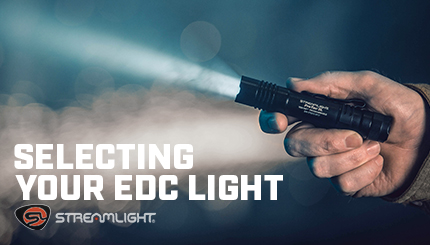Press Releases Detail
Please wait while results are retrieved...
There is a wide selection of flashlights to choose from as there have been substantial increases in technology over the past few years. This has introduced a wide range of new lights into the market.
Selecting an Everyday Carry Light still remains primarily a personal preference, but there are some key factors to keep in mind when narrowing down your selection.
One major factor is that the light needs to work for you, meet your needs and applications. Just because the light works well for someone else does not mean that it is the right light for you.
Some of the basic requirements are size of the light, how you are going to carry the light, the programs/switches, how is the light activated and run, the output level of the light, and power source/runtime.
Technology has allowed us to create smaller, brighter lights. However, the size of the light still needs to fit your needs. Physically the light needs to be comfortable, and you need to be able to reach the switch to be able to function the light flawlessly. If you have larger hands a small keychain light might not be optimal. A larger light may be cumbersome for someone with smaller hands, and not allow you to reach the switches and function the light properly. Where and how you are going to carry the light should also be a consideration. Is it a pocket light, a holstered light, hooked to a pack or gear straps, etc. It is important that it be easily accessible and able to function quickly.
The type of switch on the light should also be considered. Is it a rear tailcap button, side button, or side roller switch? All will work, but you are looking to optimize the light. If the light is going to be used with a firearm, what grip are you most comfortable using and does the light’s design fit that shooting style? You should practice the technique you are going to use until it is second nature and very smooth for you to utilize. Some lights also offer different programs/functions, and this offers the user more options to meet their functional needs. Don’t let all the button taps and programs overwhelm you as you will most likely need the light to be deployed quickly and function easily under stress.
Output is a major factor in your EDC light selection. Although many think that the most light possible is best (highest lumens), that is not always the case. You should choose a light that provides a good balance of output, run time, and size. Generally, the larger LED lights will have more beam spread and down range light vs the smaller keychain size lights. Your best pattern will have a hot spot in the center of the beam with an arch or periphery of light around the hot spot. This will give you the best beam pattern for all round use. Too tight a beam pattern could limit you in seeing the larger area around you, and too much beam spread will not generally illuminate down range as may be required. If you are going to deploy your light, odds are you are in a darker or low light environment and your eyes are adapted to the ambient light, 1,000-2,000 lumens in a confined space could momentarily blind you as well or will be painful if you are night adapted (sleeping…). Keep in mind, how far are you going to engage a target with your EDC light…
What power source is best for you? There have been advancements in battery technology, and this has made batteries smaller and given them a higher capacity to run things longer. The new rechargeable platforms are also greatly improved over older battery chemistries. Most of the higher output lights will be powered by a lithium battery (rechargeable or disposable). These are available in a full range of sizes and shapes. The batteries have some advantages and disadvantages. The advantages are performance, run times, and overall capacities while a disadvantage is that the cost tends to be higher over alkaline type batteries. The self-discharge (battery charge dropping while not in use) with lithium is very low, and this is an advantage if you are looking for low maintenance (charging or replacing batteries). Some lights will also have battery charge indicators to let you know when the battery is running low and needs to be recharged or replaced.
These are some of the features to consider when selecting your EDC light. Again, the most important consideration is that the light fits you and functions in accordance with your applications.
PHONE
1-800-523-74881-610-631-0600
FAX
1-800-220-70071-610-631-0712


